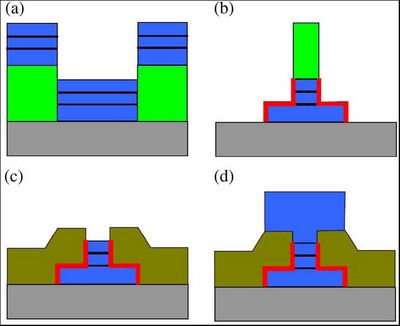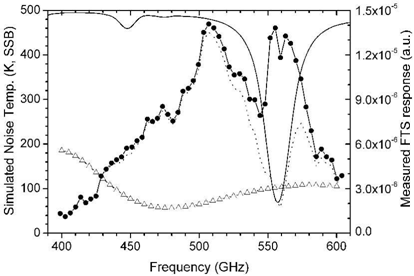Twin SIS (superconductor-insulator-superconductor) junctions, with a simple structure, yet large bandwidth and low noise temperature, have been widely used in millimeter- and submillimeter-wave heterodyne mixers. With increasing frequency, however, the length of the tuning inductance connecting the two individual SIS junctions becomes short while the junction area remains fixed. With a relatively short tuning inductance, the effect of the junction’s spreading inductance becomes non-negligible, and device fabrication becomes more difficult. By adopting vertically stacked SIS junctions (VSJs), which have an equivalent geometric capacitance inversely proportional to the junction number, it becomes feasible to increase the junction tuning inductance.

(image by LI Jing)
Fig. 1. Simulated mixer noise temperature (K, image) and mixer conversion gain (dB, contours), both in SSB mode, at 500 GHz for the twin VSJs with the optimized tuning inductance. Results are shown as a function of normalized RF admittance (horizontal axis: normalized susceptance; vertical axis: inverse of normalized conductance).

(image by LI Jing)
Fig. 2. Schematic fabrication procedures for VSJs, with (a) deposition of Nb/Al–AlOx/Nb/Al–AlOx/Nb multi-layer, (b) VSJ patterning and anodization, (c) layer deposition and patterning, and (d) Nb wiring-layer deposition and patterning.

(image by LI Jing)
Fig. 3. Measured FTS response (dotted line) and that (line with solid circle) corrected for the water-vapor absorption (solid line), compared with the simulated response for the receiver noise temperature (line with open triangle).
The twin Nb/Al-AlOx/Nb/Al-AlOx/Nb VSJ mixer device for the 500-GHz frequency band has been designed and fabricated. The SSB receiver noise temperature simulated for a 500-GHz waveguide mixer incorporating the twin VSJ device is as low as 100 K in the range of 440-600 GHz. Fabricated VSJ mixer devices have exhibited a gap voltage of about 5.5 mV and reasonably good quality factor, but their uniformity (the upper and lower junction in particular) is to be improved. The frequency response of fabricated VSJ mixer devices, measured by an FTS, appears to be in reasonably good agreement with the simulated one. With their larger tuning inductance and higher saturation level, twin VSJ devices may find good use in superconducting mixers at millimeter and submillimeter wavelengths. The work by Li Jing and SHI Shengcai et. accepted by IEEE TRANSACTIONS ON APPLIED SUPERCONDUCTIVITY has been published online(http://ieeexplore.ieee.org/xpl/tocresult.jsp?asf_arn=null&asf_iid=5776769&asf_pun=null&asf_in=null&asf_rpp=null&asf_iv=null&asf_sp=null&asf_pn=15 ) |
